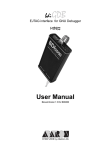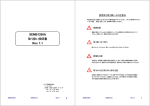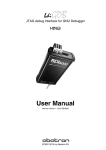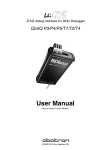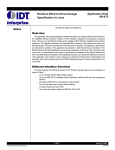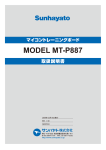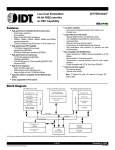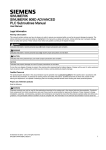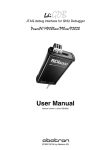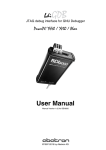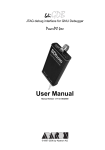Download bdiGDB User Manual
Transcript
bdi GDB
JTAG debug interface for GNU Debugger
MIPS32
User Manual
Manual Version 1.04 for BDI3000
©1997-2015 by Abatron AG
bdiGDB for GNU Debugger, BDI3000 (MIPS32)
User Manual
2
1 Introduction ................................................................................................................................. 4
1.1 BDI3000................................................................................................................................. 4
1.2 BDI Configuration .................................................................................................................. 5
2 Installation ................................................................................................................................... 6
2.1 Connecting the BDI3000 to Target ........................................................................................ 6
2.2 Connecting the BDI3000 to Power Supply ............................................................................ 8
2.3 Status LED «MODE»............................................................................................................. 9
2.4 Connecting the BDI3000 to Host ......................................................................................... 10
2.4.1 Serial line communication .......................................................................................... 10
2.4.2 Ethernet communication ............................................................................................ 11
2.5 Installation of the Configuration Software ............................................................................ 12
2.5.1 Configuration with a Linux / Unix host........................................................................ 13
2.5.2 Configuration with a Windows host ............................................................................ 15
2.5.3 Configuration via Telnet / TFTP ................................................................................. 17
2.6 Testing the BDI3000 to host connection.............................................................................. 19
2.7 TFTP server for Windows .................................................................................................... 19
3 Using bdiGDB ............................................................................................................................ 20
3.1 Principle of operation ........................................................................................................... 20
3.2 Configuration File................................................................................................................. 21
3.2.1 Part [INIT]................................................................................................................... 22
3.2.2 Part [TARGET] ........................................................................................................... 24
3.2.3 Part [HOST]................................................................................................................ 29
3.2.4 Part [FLASH] .............................................................................................................. 31
3.2.5 Part [REGS] ............................................................................................................... 35
3.3 Debugging with GDB ........................................................................................................... 37
3.3.1 Target setup ............................................................................................................... 37
3.3.2 Connecting to the target............................................................................................. 37
3.3.3 Breakpoint Handling................................................................................................... 38
3.3.4 GDB monitor command.............................................................................................. 38
3.3.5 Target serial I/O via BDI............................................................................................. 39
3.3.6 Embedded Linux MMU Support ................................................................................. 40
3.4 Telnet Interface.................................................................................................................... 42
3.5 Multi-Core Support............................................................................................................... 45
3.5.1 MIPS 34K MT ASE Support ....................................................................................... 46
4 Specifications ............................................................................................................................ 48
5 Environmental notice................................................................................................................ 49
6 Declaration of Conformity (CE)................................................................................................ 49
7 Warranty and Support Terms................................................................................................... 50
7.1 Hardware ............................................................................................................................. 50
7.2 Software .............................................................................................................................. 50
7.3 Warranty and Disclaimer ..................................................................................................... 50
7.4 Limitation of Liability ............................................................................................................ 50
© Copyright 1997-2015 by ABATRON AG Switzerland
V 1.04
bdiGDB for GNU Debugger, BDI3000 (MIPS32)
User Manual
3
7 Appendices
A Troubleshooting ....................................................................................................................... 51
B Maintenance .............................................................................................................................. 52
C Trademarks ............................................................................................................................... 52
© Copyright 1997-2015 by ABATRON AG Switzerland
V 1.04
bdiGDB for GNU Debugger, BDI3000 (MIPS32)
User Manual
4
1 Introduction
bdiGDB enhances the GNU debugger (GDB), with EJTAG debugging for MIPS32 based targets.
With the built-in Ethernet interface you get a very fast code download speed. No target communication channel (e.g. serial line) is wasted for debugging purposes. Even better, you can use fast Ethernet debugging with target systems without network capability. The host to BDI communication uses
the standard GDB remote protocol.
An additional Telnet interface is available for special debug tasks (e.g. force a hardware reset,
program flash memory).
The following figure shows how the BDI3000 interface is connected between the host and the target:
Target System
MIPS
32
EJTAG Interface
UNIX / PC Host
BDI3000
GNU Debugger
(GDB)
Ethernet (10/100 BASE-T)
1.1 BDI3000
The BDI3000 is the main part of the bdiGDB system. This small box implements the interface between the JTAG pins of the target CPU and a 10/100Base-T Ethernet connector. The firmware of the
BDI3000 can be updated by the user with a simple Linux/Windows configuration program or interactively via Telnet/TFTP. The BDI3000 supports 1.2 – 5.0 Volts target systems.
.
© Copyright 1997-2015 by ABATRON AG Switzerland
V 1.04
bdiGDB for GNU Debugger, BDI3000 (MIPS32)
User Manual
5
1.2 BDI Configuration
As an initial setup, the IP address of the BDI3000, the IP address of the host with the configuration
file and the name of the configuration file is stored within the flash of the BDI3000.
Every time the BDI3000 is powered on, it reads the configuration file via TFTP.
Following an example of a typical configuration file:
; bdiGDB configuration file for IDT79S334A board
; ---------------------------------------------;
[INIT]
; Setup Internal Bus
WM32
0xFFFFE200
0xAA82AAAA
;CPU Port Width Register, Flash 32bit
WM32
0xFFFFE204
0x3FFFFFFF
;CPU BTA Register
WM32
0xB8000000
0x3FFFFFFF
;BTA Register
WM32
0xB8000004
0x00000007
;Address Latch Timing Register
;
WCP0
12
0x10010000
;Setup Status Register, clear BEV
WCP0
13
0x00000000
;Clear Cause Register
WCP0
16
0x00000003
;Set kseg0 coherency
WM32
0xB8000730
0x00000000
;Disable Watchdog Timer
;
; Init memory controller
WM32
0xB8000080
0x1FC00000
;Memory Base Address Bank 0, Flash
WM32
0xB8000084
0xFFC00000
;Memory Base Mask
Bank 0, Flash
WM32
0xB8000088
0x04000000
;Memory Base Address Bank 1, SRAM
WM32
0xB800008C
0xFFF00000
;Memory Base Mask
Bank 1, SRAM
WM32
0xB8000200
0x00002884
;Memory Control Bank 0, Flash 32bit
WM32
0xB8000204
0x00002863
;Memory Control Bank 1, SRAM
....
;
[TARGET]
JTAGCLOCK
CPUTYPE
ENDIAN
WORKSPACE
BREAKMODE
VECTOR
;
[HOST]
IP
FILE
FORMAT
LOAD
;
[FLASH]
WORKSPACE
CHIPTYPE
CHIPSIZE
BUSWIDTH
FILE
ERASE
;
[REGS]
DMM1
DMM2
FILE
1
RC32300
LITTLE
0xA0000080
SOFT
CATCH
;use 8 MHz JTAG clock
;the used target CPU type
;target is little endian
;workspace in target RAM for fast download
;SOFT or HARD, HARD uses hardware breakpoints
;catch unhandled exceptions
151.120.25.115
E:\cygnus\root\usr\demo\mips\vmlinus
ELF
MANUAL
;load code MANUAL or AUTO after reset
0xa0000000
;workspace in target RAM for fast programming algorithm
AM29F
;Flash type (AM29F | AM29BX8 | AM29BX16 | I28BX8 | I28BX16)
0x80000
;The size of one flash chip in bytes (e.g. AM29F040 = 0x80000)
32
;The width of the flash memory bus in bits (8 | 16 | 32)
E:\cygnus\root\usr\demo\mips\loop_le.sss
0xBFC00000
;erase sector 0
0xFF300000
;DSU base address
0xB8000000
;Memory mapped registers
E:\cygnus\root\usr\demo\mips\reg32334.def
Based on the information in the configuration file, the target is automatically initialized after every reset.
© Copyright 1997-2015 by ABATRON AG Switzerland
V 1.04
bdiGDB for GNU Debugger, BDI3000 (MIPS32)
User Manual
6
2 Installation
2.1 Connecting the BDI3000 to Target
The cables to the target system are designed for the IDT RC32300 Development Boards (optional
available: Part# 90070) and for EJTAG 2.5 compatible boards (enclosed). In case where the target
system has the same connector layout, the cable (14 pin or 24 pin) can be directly connected.
!
In order to ensure reliable operation of the BDI (EMC, runtimes, etc.) the target cable length must not
exceed 25 cm (10").
1
23
Target System
MIPS
1
2
13
optional
available
24
(P/N 90070)
2 Key
14 pin EJTAG
Connector
14
TRGT
MODE
BDI
BDI3000
BDI
9
TARGET A
10
TARGET B
1
2
The green LED «TRGT» marked light up when target is powered up
1 - TRST
2 - NC
3 - TDI
4 - NC
5 - TDO
6 - GROUND
7 - TMS
8 - GROUND
9 - TCK
10 - NC
11 - RESET
12 - key
13 - DINT
14 - VIO Target
24 pin RC32300
Connector
1 - TRST
2 - GROUND
3 - TDI
4 - GROUND
5 - TDO
6 - GROUND
7 - TMS
8 - GROUND
9 - TCK
10 - GROUND
11 - RESET
12 - GROUND
13 - NC
14 - GROUND
15 - NC
16 - GROUND
17 - NC
18 - GROUND
19 - NC
20 - GROUND
21 - DBGBOOT
22 - GROUND
23 - VIO Target
24 - GROUND
20 - NC
For TARGET A connector signals see table on next page.
Warning:
Before you can use the BDI3000 with an other target processor type (e.g. MIPS <--> ARM), a new
setup has to be done (see chapter 2.5). During this process the target cable must be disconnected
from the target system.
!
To avoid data line conflicts, the BDI3000 must be disconnected from the target system while
programming a new firmware for an other target CPU.
© Copyright 1997-2015 by ABATRON AG Switzerland
V 1.04
bdiGDB for GNU Debugger, BDI3000 (MIPS32)
User Manual
7
TARGET A Connector Signals
Pin
Name
Description
1
DINT
EJTAG Debug Interrupt
EJTAG 2.5: This output of the BDI3000 connects to the target DINT line.
RC32300: This output of the BDI3000 connects to the target DebugBoot line.
2
TRST
EJTAG Test Reset
This output of the BDI3000 resets the JTAG TAP controller on the target.
3+5
GND
System Ground
4
TCK
EJTAG Test Clock
This output of the BDI3000 connects to the target TCK line.
6
TMS
EJTAG Test Mode Select
This output of the BDI3000 connects to the target TMS line.
7
RESET
This open collector output of the BDI3000 is used to reset the target system.
8
TDI
EJTAG Test Data In
This output of the BDI3000 connects to the target TDI line.
9
VIO Target
1.2 – 5.0V:
This is the target reference voltage. It indicates that the target has power and it is also used
to create the logic-level reference for the input comparators. It also controls the output logic
levels to the target. It is normally fed from Vdd I/O on the target board.
10
TDO
EJTAG Test Data Out
This input to the BDI3000 connects to the target TDO line.
© Copyright 1997-2015 by ABATRON AG Switzerland
V 1.04
bdiGDB for GNU Debugger, BDI3000 (MIPS32)
User Manual
8
2.2 Connecting the BDI3000 to Power Supply
The BDI3000 needs to be supplied with the enclosed power supply from Abatron (5VDC).
!
Before use, check if the mains voltage is in accordance with the input voltage printed on power
supply. Make sure that, while operating, the power supply is not covered up and not situated near
a heater or in direct sun light. Dry location use only.
!
For error-free operation, the power supply to the BDI3000 must be between 4.75V and 5.25V DC.
The maximal tolerable supply voltage is 5.25 VDC. Any higher voltage or a wrong polarity
might destroy the electronics.
+5 VDC
RS232
GND
POWER
TRGT
MODE
BDI
casing connected to ground terminal
TARGET A
TARGET B
The green LED «BDI» marked light up when 5V power is connected to the BDI3000
Please switch on the system in the following sequence:
• 1 –> external power supply
• 2 –> target system
© Copyright 1997-2015 by ABATRON AG Switzerland
V 1.04
bdiGDB for GNU Debugger, BDI3000 (MIPS32)
User Manual
9
2.3 Status LED «MODE»
MODE
TRGT
BDI
The built in LED indicates the following BDI states:
TARGET A
MODE LED
TARGET B
BDI STATES
OFF
The BDI is ready for use, the firmware is already loaded.
ON
The output voltage from the power supply is too low.
BLINK
The BDI «loader mode» is active (an invalid firmware is loaded or loading firmware is active).
© Copyright 1997-2015 by ABATRON AG Switzerland
V 1.04
bdiGDB for GNU Debugger, BDI3000 (MIPS32)
User Manual
10
2.4 Connecting the BDI3000 to Host
2.4.1 Serial line communication
Serial line communication is only used for the initial configuration of the bdiGDB system.
The host is connected to the BDI through the serial interface (COM1...COM4). The communication
cable (included) between BDI and Host is a serial cable. There is the same connector pinout for the
BDI and for the Host side (Refer to Figure below).
Target System
RS232 Connector
(for PC host)
12345
MIPS
1 - NC
2 - RXD data from host
3 - TXD data to host
4 - NC
5 - GROUND
6 - NC
7 - NC
8 - NC
9 - NC
6789
RS232
POWER
BDI3000
PC Host
RS232
© Copyright 1997-2015 by ABATRON AG Switzerland
V 1.04
bdiGDB for GNU Debugger, BDI3000 (MIPS32)
User Manual
11
2.4.2 Ethernet communication
The BDI3000 has a built-in 10/100 BASE-T Ethernet interface (see figure below). Connect an UTP
(Unshielded Twisted Pair) cable to the BD3000. Contact your network administrator if you have questions about the network.
Target System
10/100 BASE-T
Connector
1
8
MIPS
1 - TD+
2 - TD3 - RD+
4 - NC
5 - NC
6 - RD7 - NC
8 - NC
RS232
POWER
LED1
LED2
BDI3000
PC / Unix
Host
Ethernet (10/100 BASE-T)
The following explains the meanings of the built-in LED lights:
LED
Function
Description
LED 1
(green)
Link / Activity
When this LED light is ON, data link is successful between the UTP port
of the BDI3000 and the hub to which it is connected.
The LED blinks when the BDI3000 is receiving or transmitting data.
LED 2
(amber)
Speed
When this LED light is ON, 100Mb/s mode is selected (default).
When this LED light is OFF, 10Mb/s mode is selected
© Copyright 1997-2015 by ABATRON AG Switzerland
V 1.04
bdiGDB for GNU Debugger, BDI3000 (MIPS32)
User Manual
12
2.5 Installation of the Configuration Software
On the enclosed diskette you will find the BDI configuration software and the firmware required for
the BDI3000. For Windows users there is also a TFTP server included.
The following files are on the diskette.
b30r4kgd.exe
Windows Configuration program
b30r4kgd.xxx
Firmware for the BDI3000
tftpsrv.exe
TFTP server for Windows (WIN32 console application)
*.cfg
Configuration files
*.def
Register definition files
loop_le.sss
S-record file with a short little endian endless loop mapped to 0xBFC00000
loop_be.sss
S-record file with a short big endian endless loop mapped to 0xBFC00000
bdisetup.zip
ZIP Archive with the Setup Tool sources for Linux / UNIX hosts.
Overview of an installation / configuration process:
• Create a new directory on your hard disk
• Copy the entire contents of the enclosed diskette into this directory
• Linux only: extract the setup tool sources and build the setup tool
• Use the setup tool or Telnet (default IP) to load/update the BDI firmware
Note: A new BDI has no firmware loaded.
• Use the setup tool or Telnet (default IP) to load the initial configuration parameters
- IP address of the BDI.
- IP address of the host with the configuration file.
- Name of the configuration file. This file is accessed via TFTP.
- Optional network parameters (subnet mask, default gateway).
Activating BOOTP:
The BDI can get the network configuration and the name of the configuration file also via BOOTP.
For this simple enter 0.0.0.0 as the BDI’s IP address (see following chapters). If present, the subnet
mask and the default gateway (router) is taken from the BOOTP vendor-specific field as defined in
RFC 1533.
With the Linux setup tool, simply use the default parameters for the -c option:
[root@LINUX_1 bdisetup]# ./bdisetup -c -p/dev/ttyS0 -b57
The MAC address is derived from the serial number as follows:
MAC: 00-0C-01-xx-xx-xx , replace the xx-xx-xx with the 6 left digits of the serial number
Example: SN# 33123407 ==>> 00-0C-01-33-12-34
Default IP: 192.168.53.72
Before the BDI is configured the first time, it has a default IP of 192.168.53.72 that allows an initial
configuration via Ethernet (Telnet or Setup Tools). If your host is not able to connect to this default
IP, then the initial configuration has to be done via the serial connection.
© Copyright 1997-2015 by ABATRON AG Switzerland
V 1.04
bdiGDB for GNU Debugger, BDI3000 (MIPS32)
User Manual
13
2.5.1 Configuration with a Linux / Unix host
The firmware update and the initial configuration of the BDI3000 is done with a command line utility.
In the ZIP Archive bdisetup.zip are all sources to build this utility. More information about this utility
can be found at the top in the bdisetup.c source file. There is also a make file included.
Starting the tool without any parameter displays information about the syntax and parameters.
!
To avoid data line conflicts, the BDI3000 must be disconnected from the target system while
programming the firmware for an other target CPU family.
Following the steps to bring-up a new BDI3000:
1. Build the setup tool:
The setup tool is delivered only as source files. This allows to build the tool on any Linux / Unix host.
To build the tool, simply start the make utility.
[root@LINUX_1 bdisetup]# make
cc -O2
-c -o bdisetup.o bdisetup.c
cc -O2
-c -o bdicnf.o bdicnf.c
cc -O2
-c -o bdidll.o bdidll.c
cc -s bdisetup.o bdicnf.o bdidll.o -o bdisetup
2. Check the serial connection to the BDI:
With "bdisetup -v" you may check the serial connection to the BDI. The BDI will respond with information about the current loaded firmware and network configuration.
Note: Login as root, otherwise you probably have no access to the serial port.
$ ./bdisetup -v -p/dev/ttyS0 -b115
BDI Type : BDI3000 (SN: 30000154)
Loader
: V1.00
Firmware : unknown
MAC
: ff-ff-ff-ff-ff-ff
IP Addr : 255.255.255.255
Subnet
: 255.255.255.255
Gateway : 255.255.255.255
Host IP : 255.255.255.255
Config
: ÿÿÿÿÿÿÿ........
3. Load/Update the BDI firmware:
With "bdisetup -u" the firmware is programmed into the BDI3000 flash memory. This configures the
BDI for the target you are using. Based on the parameters -a and -t, the tool selects the correct firmware file. If the firmware file is in the same directory as the setup tool, there is no need to enter a -d
parameter.
$ ./bdisetup -u -p/dev/ttyS0 -b115 -aGDB -tMIPS
Connecting to BDI loader
Programming firmware with ./b30r4kgd.100
Erasing firmware flash ....
Erasing firmware flash passed
Programming firmware flash ....
Programming firmware flash passed
© Copyright 1997-2015 by ABATRON AG Switzerland
V 1.04
bdiGDB for GNU Debugger, BDI3000 (MIPS32)
User Manual
14
4. Transmit the initial configuration parameters:
With "bdisetup -c" the configuration parameters are written to the flash memory within the BDI.
The following parameters are used to configure the BDI:
BDI IP Address
The IP address for the BDI3000. Ask your network administrator for assigning an IP address to this BDI3000. Every BDI3000 in your network
needs a different IP address.
Subnet Mask
The subnet mask of the network where the BDI is connected to. A subnet
mask of 255.255.255.255 disables the gateway feature. Ask your network
administrator for the correct subnet mask. If the BDI and the host are in
the same subnet, it is not necessary to enter a subnet mask.
Default Gateway
Enter the IP address of the default gateway. Ask your network administrator for the correct gateway IP address. If the gateway feature is disabled,
you may enter 255.255.255.255 or any other value.
Config - Host IP Address Enter the IP address of the host with the configuration file. The configuration file is automatically read by the BDI after every start-up via TFTP.
If the host IP is 255.255.255.255 then the setup tool stores the configuration read from the file into the BDI internal flash memory. In this case no
TFTP server is necessary.
Configuration file
Enter the full path and name of the configuration file. This file is read by
the setup tool or via TFTP. Keep in mind that TFTP has it’s own root directory (usual /tftpboot).
$ ./bdisetup -c -p/dev/ttyS0 -b115 \
> -i151.120.25.102 \
> -h151.120.25.112 \
> -fe:/bdi3000/mytarget.cfg
Connecting to BDI loader
Writing network configuration
Configuration passed
5. Check configuration and exit loader mode:
The BDI is in loader mode when there is no valid firmware loaded or you connect to it with the setup
tool. While in loader mode, the Mode LED is blinking. The BDI will not respond to network requests
while in loader mode. To exit loader mode, the "bdisetup -v -s" can be used. You may also power-off
the BDI, wait some time (1min.) and power-on it again to exit loader mode.
$ ./bdisetup -v -p/dev/ttyS0 -b115 -s
BDI Type : BDI3000 (SN: 30000154)
Loader
: V1.00
Firmware : V1.00 bdiGDB for MIPS32
MAC
: 00-0c-01-30-00-01
IP Addr : 151.120.25.102
Subnet
: 255.255.255.255
Gateway : 255.255.255.255
Host IP : 151.120.25.112
Config
: /bdi3000/mytarget.cfg
The Mode LED should go off, and you can try to connect to the BDI via Telnet.
$ telnet 151.120.25.102
© Copyright 1997-2015 by ABATRON AG Switzerland
V 1.04
bdiGDB for GNU Debugger, BDI3000 (MIPS32)
User Manual
15
2.5.2 Configuration with a Windows host
First make sure that the BDI is properly connected (see Chapter 2.1 to 2.4).
!
To avoid data line conflicts, the BDI3000 must be disconnected from the target system while
programming the firmware for an other target CPU family.
dialog box «BDI3000 Update/Setup»
Before you can use the BDI3000 together with the GNU debugger, you must store the initial configuration parameters in the BDI3000 flash memory. The following options allow you to do this:
Port
Select the communication port where the BDI3000 is connected during
this setup session. If you select Network, make sure the Loader is already
active (Mode LED blinking). If there is already a firmware loaded and running, use the Telnet command "boot loader" to activate Loader Mode.
Speed
Select the baudrate used to communicate with the BDI3000 loader during
this setup session.
Connect
Click on this button to establish a connection with the BDI3000 loader.
Once connected, the BDI3000 remains in loader mode until it is restarted
or this dialog box is closed.
Current
Press this button to read back the current loaded BDI3000 firmware version. The current firmware version will be displayed.
© Copyright 1997-2015 by ABATRON AG Switzerland
V 1.04
bdiGDB for GNU Debugger, BDI3000 (MIPS32)
User Manual
16
Erase
Press this button to erase the current loaded firmware.
Update
This button is only active if there is a newer firmware version present in the
execution directory of the bdiGDB setup software. Press this button to
write the new firmware into the BDI3000 flash memory.
BDI IP Address
Enter the IP address for the BDI3000. Use the following format:
xxx.xxx.xxx.xxx e.g.151.120.25.101
Ask your network administrator for assigning an IP address to this
BDI3000. Every BDI3000 in your network needs a different IP address.
Subnet Mask
Enter the subnet mask of the network where the BDI is connected to.
Use the following format: xxx.xxx.xxx.xxxe.g.255.255.255.0
A subnet mask of 255.255.255.255 disables the gateway feature.
Ask your network administrator for the correct subnet mask.
Default Gateway
Enter the IP address of the default gateway. Ask your network administrator for the correct gateway IP address. If the gateway feature is disabled,
you may enter 255.255.255.255 or any other value.
Config - Host IP Address Enter the IP address of the host with the configuration file. The configuration file is automatically read by the BDI after every start-up via TFTP.
If the host IP is 255.255.255.255 then the setup tool stores the configuration read from the file into the BDI internal flash memory. In this case no
TFTP server is necessary.
Configuration file
Enter the full path and name of the configuration file. This file is read by
the setup tool or via TFTP.
Transmit
Click on this button to store the configuration in the BDI3000 flash
memory.
Note:
Using this setup tool via the Network channel is only possible if the BDI3000 is already in Loader
mode (Mode LED blinking). To force Loader mode, enter "boot loader" at the Telnet. The setup tool
tries first to establish a connection to the Loader via the IP address present in the "BDI IP Address"
entry field. If there is no connection established after a time-out, it tries to connect to the default IP
(192.168.53.72).
© Copyright 1997-2015 by ABATRON AG Switzerland
V 1.04
bdiGDB for GNU Debugger, BDI3000 (MIPS32)
User Manual
17
2.5.3 Configuration via Telnet / TFTP
The firmware update and the initial configuration of the BDI3000 can also be done interactively via a
Telnet connection and a running TFTP server on the host with the firmware file. In cases where it is
not possible to connect to the default IP, the initial setup has to be done via a serial connection.
!
To avoid data line conflicts, the BDI3000 must be disconnected from the target system while
programming the firmware for an other target CPU family.
Following the steps to bring-up a new BDI3000 or updating the firmware.
Connect to the BDI Loader via Telnet.
If a firmware is already running enter "boot loader" and reconnect via Telnet.
$ telnet 192.168.53.72
or
$ telnet <your BDI IP address>
Update the network parameters so it matches your needs:
LDR>network
BDI MAC
BDI IP
BDI Subnet
BDI Gateway
Config IP
Config File
:
:
:
:
:
:
00-0c-01-30-00-01
192.168.53.72
255.255.255.0
255.255.255.255
255.255.255.255
LDR>netip 151.120.25.102
LDR>nethost 151.120.25.112
LDR>netfile /bdi3000/mytarget.cfg
LDR>network
BDI MAC
BDI IP
BDI Subnet
BDI Gateway
Config IP
Config File
:
:
:
:
:
:
00-0c-01-30-00-01
151.120.25.102
255.255.255.0
255.255.255.255
151.120.25.112
/bdi3000/mytarget.cfg
LDR>network save
saving network configuration ... passed
BDI MAC
: 00-0c-01-30-00-01
BDI IP
: 151.120.25.102
BDI Subnet : 255.255.255.0
BDI Gateway : 255.255.255.255
Config IP
: 151.120.25.112
Config File : /bdi3000/mytarget.cfg
In case the subnet has changed, reboot before trying to load the firmware
LDR>boot loader
© Copyright 1997-2015 by ABATRON AG Switzerland
V 1.04
bdiGDB for GNU Debugger, BDI3000 (MIPS32)
User Manual
18
Connect again via Telnet and program the firmware into the BDI flash:
$ telnet 151.120.25.102
LDR>info
BDI Firmware:
BDI CPLD ID :
BDI CPLD UES:
BDI MAC
:
BDI IP
:
BDI Subnet :
BDI Gateway :
Config IP
:
Config File :
not loaded
01285043
ffffffff
00-0c-01-30-00-01
151.120.25.102
255.255.255.0
255.255.255.255
151.120.25.112
/bdi3000/mytarget.cfg
LDR>fwload e:/temp/b30r4kgd.100
erasing firmware flash ... passed
programming firmware flash ... passed
LDR>info
BDI Firmware:
BDI CPLD ID :
BDI CPLD UES:
BDI MAC
:
BDI IP
:
BDI Subnet :
BDI Gateway :
Config IP
:
Config File :
LDR>
32 / 1.00
01285043
ffffffff
00-0c-01-30-00-01
151.120.25.102
255.255.255.0
255.255.255.255
151.120.25.112
/bdi3000/mytarget.cfg
To boot now into the firmware use:
LDR>boot
The Mode LED should go off, and you can try to connect to the BDI again via Telnet.
telnet 151.120.25.102
© Copyright 1997-2015 by ABATRON AG Switzerland
V 1.04
bdiGDB for GNU Debugger, BDI3000 (MIPS32)
User Manual
19
2.6 Testing the BDI3000 to host connection
After the initial setup is done, you can test the communication between the host and the BDI3000.
There is no need for a target configuration file and no TFTP server is needed on the host.
• If not already done, connect the BDI3000 system to the network.
• Power-up the BDI3000.
• Start a Telnet client on the host and connect to the BDI3000 (the IP address you entered during initial configuration).
• If everything is okay, a sign on message like «BDI Debugger for Embedded PowerPC» and
a list of the available commands should be displayed in the Telnet window.
2.7 TFTP server for Windows
The bdiGDB system uses TFTP to access the configuration file and to load the application program.
Because there is no TFTP server bundled with Windows, Abatron provides a TFTP server application
tftpsrv.exe. This WIN32 console application runs as normal user application (not as a system service).
Command line syntax:
tftpsrv [p] [w] [dRootDirectory]
Without any parameter, the server starts in read-only mode. This means, only read access request
from the client are granted. This is the normal working mode. The bdiGDB system needs only read
access to the configuration and program files.
The parameter [p] enables protocol output to the console window. Try it.
The parameter [w] enables write accesses to the host file system.
The parameter [d] allows to define a root directory.
tftpsrv p
Starts the TFTP server and enables protocol output
tftpsrv p w
Starts the TFTP server, enables protocol output and write accesses are
allowed.
tftpsrv dC:\tftp\
Starts the TFTP server and allows only access to files in C:\tftp and its
subdirectories. As file name, use relative names.
For example "bdi\mpc750.cfg" accesses "C:\tftp\bdi\mpc750.cfg"
You may enter the TFTP server into the Startup group so the server is started every time you login.
© Copyright 1997-2015 by ABATRON AG Switzerland
V 1.04
bdiGDB for GNU Debugger, BDI3000 (MIPS32)
User Manual
20
3 Using bdiGDB
3.1 Principle of operation
The firmware within the BDI handles the GDB request and accesses the target memory or registers
via the JTAG interface. There is no need for any debug software on the target system. After loading
the code via TFTP debugging can begin at the very first assembler statement.
Whenever the BDI system is powered-up the following sequence starts:
Power On
initial
configuration
valid?
no
yes
activate BDI3000 loader
Get configuration file
via TFTP
Reset System and
Process target init list
Power OFF
Process GDB requests
Process Telnet commands
Power OFF
© Copyright 1997-2015 by ABATRON AG Switzerland
V 1.04
bdiGDB for GNU Debugger, BDI3000 (MIPS32)
User Manual
21
3.2 Configuration File
The configuration file is automatically read by the BDI3000 after every power on.
The syntax of this file is as follows:
; comment
[part name]
identifier parameter1
identifier parameter1
.....
[part name]
identifier parameter1
identifier parameter1
.....
etc.
parameter2 ..... parameterN
parameter2 ..... parameterN
; comment
parameter2 ..... parameterN
parameter2 ..... parameterN
Numeric parameters can be entered as decimal (e.g. 700) or as hexadecimal (0x80000).
Note for IDR RC32300 processors:
The debug boot function on IDT RC323000 processors does not work. Therefore the EJTAG debug
interface can not always get control over the processor if there is no valid code in the boot ROM. If
there is an empty boot flash, the BDI may need multiple reset sequences until it gets control over the
processor. It is recommended to program at least a small endless loop into the boot flash. On the
distribution diskette you will find the appropriate S-record files with this small loop code. One for little
endian and one for big endian systems.
Also the hardware breakpoint logic inside the RC32300 does not always work as expected. It is highly
recommended to use only BREAKMODE SOFT and STEPMODE SWBP. In cases where it is absolutely necessary to use hardware breakpoints (debugging ROM code) use the HWBP’s very defensive. Do not set breakpoints following load/store instructions or following a branch with a load/store
instruction in the branch delay slot. This is especially important if the code is cached.
© Copyright 1997-2015 by ABATRON AG Switzerland
V 1.04
bdiGDB for GNU Debugger, BDI3000 (MIPS32)
User Manual
22
3.2.1 Part [INIT]
The part [INIT] defines a list of commands which should be executed every time the target comes out
of reset. The commands are used to get the target ready for loading the program file.
WGPR register value
Write value to the selected general purpose register.
register
the register number 0 .. 31
value
the value to write into the register
Example:
WGPR 0 5
WREG name value
Write value to the selected register/memory by name
name
the case sensitive register name from the reg def file
value
the value to write to the register/memory
Example:
WREG pc 0xbfc00000
WCP0 register value
Write value to the selected Coprocessor 0 register.
register
the register number 0 .. 31, add 0x0n00 for Select n
value
the value to write into the register
Example:
WCP0 13 0x00000000 ;Clear Cause Register
RCP0 register
Read the selected Coprocessor 0 register.
register
the register number 0 .. 31, add 0x0n00 for Select n
Example:
RCP0 16 ; Read Config0
WM8 address value
Write a byte (8bit) to the selected memory place.
address
the memory address
value
the value to write to the target memory
Example:
WM8 0xFFFFFA21 0x04 ; SYPCR: watchdog disable ...
WM16 address value
Write a half word (16bit) to the selected memory place.
address
the memory address
value
the value to write to the target memory
Example:
WM16 0x02200200 0x0002 ; TBSCR
WM32 address value
Write a word (32bit) to the selected memory place.
address
the memory address
value
the value to write to the target memory
Example:
WM32 0x02200000 0x01632440 ; SIUMCR
RM8 address value
Read a byte (8bit) from the selected memory place.
address
the memory address
Example: RM8 0x00000000
RM16 address value
Read a half word (16bit) from the selected memory place.
address
the memory address
Example: RM16 0x00000000
RM32 address value
Read a word (32bit) from the selected memory place.
address
the memory address
Example: RM32 0x00000000
© Copyright 1997-2015 by ABATRON AG Switzerland
V 1.04
bdiGDB for GNU Debugger, BDI3000 (MIPS32)
User Manual
23
DELAY value
Delay for the selected time.
value
the delay time in milliseconds (1...30000)
Example:
DELAY 500 ; delay for 0.5 seconds
IVIC ways sets
This entry invalidates the instruction cache.
way
the number of ways in the IC
sets
the number of sets in the IC
Example:
IVIC 2 256 ; Invalidate IC, 2 way, 256 sets
IVDC ways sets
This entry invalidates the data cache.
way
the number of ways in the DC
sets
the number of sets in the DC
Example:
IVDC 2 64 ; Invalidate DC, 2 way, 64 sets
WTLB vpn rpn
Adds an entry to the TLB array. For parameter description see below.
vpn
the virtual page number, size and ASID
rpn
the real page number, coherency and DVG bits
Example:
WTLB 0x00000500 0x01FC0017 ;Boot ROM 2 x 1MB
Adding entries to the TLB:
Sometimes it is necessary to setup the TLB before memory can be accessed. This is because on a
MIPS the MMU is always enabled. The init list entry WTLB allows an initial setup of the TLB array.
The first WTLB entry clears also the whole TLB array.
The vpn parameter defines the effective page number, size and ASID:
+-------------------+-+----+--------+
|
VPN
|-|SIZE| ASID |
+-------------------+-+----+--------+
19
1 4
8
The SIZE field decodes as follows:
0 = (1KB)
5 = 1MB
1 = 4KB
6 = 4MB
2 = 16KB
7 = 16MB
3 = 64KB
8 = 64MB
4 = 256KB
9 = 256MB
The rpn parameter defines the real page number, coherency and DVG bits:
+----+-------------------+--+---+---+
|ERPN|
RPN
|--| C |DVG|
+----+-------------------+--+---+---+
4
20
2
3
3
The field ERPN (extended real page number) is used for physical address bits 35:32.
The field positions are selected so the physical address becomes readable.
The following example clears the TLB and adds one entry to access ROM via address 0x00000000.
[INIT]
; Setup TLB
WTLB
0x00000500
0x01FC0017
;Boot ROM 2 x 1MB, uncached DVG
© Copyright 1997-2015 by ABATRON AG Switzerland
V 1.04
bdiGDB for GNU Debugger, BDI3000 (MIPS32)
User Manual
24
3.2.2 Part [TARGET]
The part [TARGET] defines some target specific values.
CPUTYPE type [MIPS16] This value gives the BDI information about the connected CPU. The optional parameter MIPS16 forces the BDI to use 16-bit software breakpoints in any case. If this parameter is not present, the "length" parameter
of the GDB Z0 packet selects between 32-bit and 16-bit breakpoints.
type
RC32300, AU1000, M4K, M4KE, M24K, M34K, M74K
M1004K, M1074K, EJTAG20, iAptiv
Example:
CPUTYPE M4KE
ENDIAN format
This entry defines the endiannes of the memory system.
format
The endiannes of the target memory:
BIG (default), LITTLE
Example:
ENDIAN LITTLE
JTAGCLOCK value
With this value you select the JTAG clock frequency.
value
The JTAG clock frequency in Hertz or an index value
from the following table:
0 = 32 MHz
3 = 8 MHz
1 = 16 MHz
4 = 5 MHz
2 = 11 MHz
5 = 4 MHz
Example:
JTAGCLOCK 1 ; JTAG clock is 16 MHz
JTAGDELAY wait
This entry defines a wait time in Run-Test/Idle state before a value is read
or after a value was written via JTAG. Useful when accessing slow memory with a fast JTAG clock. Allows to optimize download performance.
wait
number of 8 TCK’s in Run-Test/Idle state
Example:
JTAGDELAY 4 ; Wait for 32 TCK’s
BDIMODE mode [param] This parameter selects the BDI debugging mode. The following modes are
supported:
LOADONLY Loads and starts the application code. No debugging via
JTAG port.
AGENT
The debug agent runs within the BDI. There is no need
for any debug software on the target. This mode accepts
a second parameter. If RUN is entered as a second parameter, the loaded application will be started immediately.
Example:
BDIMODE AGENT RUN
RESET type [time]
This parameter selects the type of reset the BDI applies to the target during power-up or when "reset" is entered via Telnet. Default is HARD.
NONE
No reset is applied.
JTAG
Reset is forced via the EJTAG control register.
HARD
Reset is applied via the EJTAG connector reset pin.
The "time" parameter defines the time in milliseconds
the BDI assert the reset signal.
Example:
RESET JTAG
© Copyright 1997-2015 by ABATRON AG Switzerland
V 1.04
bdiGDB for GNU Debugger, BDI3000 (MIPS32)
User Manual
25
POWERUP delay
This parameter defines a delay in milliseconds the BDI waits after the target has been powered-up until JTAG communications starts.
delay
the power-up start delay in milliseconds (default 2 sec.)
Example:
POWERUP 5000
;start delay after power-up
WAKEUP time
This entry in the init list allows to define a delay time (in ms) the BDI inserts
between releasing the RESET line and starting communicating with the
target. This init list entry may be necessary if RESET is delayed on its way
to the processors reset pin.
time
the delay time in milliseconds
Example:
WAKEUP 3000 ; insert 3sec wake-up time
STARTUP mode [runtime]This parameter selects the target startup mode:
HALT
This default mode tries to forces the target to debug
mode immediately out of reset.
STOP
In this mode, the BDI lets the target execute code for
"runtime" milliseconds after reset. This mode is useful
when monitor code should initialize the target system.
RUN
After reset, the target executes code until stopped by the
Telnet "halt" command.
Example:
STARTUP STOP 3000 ; let the CPU run for 3 seconds
BREAKMODE mode
This parameter defines how breakpoints are implemented. The current
mode can also be changed via the Telnet interface
SOFT
This is the normal mode. Breakpoints are implemented
by replacing code with a SDBBR instruction.
HARD
In this mode, the EJTAG breakpoint hardware is used.
Example:
BREAKMODE HARD
STEPMODE mode
This parameter defines how single step (instruction step) is implemented.
The alternate step modes (HWBP or SWBP) are useful when stepping instructions that causes a TLB miss exception. Not all targets allow to use
all step modes. Some of them do not implement the EJTAG step mode
(e.g. RC32300) others support only one hardware instruction breakpoint.
JTAG
This is the default mode. The step feature of the EJTAG
debug interface is used for single stepping.
HWBP
In this mode, one or two hardware breakpoints are used
to implement single stepping.
SWBP
In this mode, one or two software breakpoints are used
to implement single stepping.
Example:
STEPMODE HWBP
VECTOR CATCH
When this line is present, the BDI catches all unhandled exceptions.
Catching exceptions is only possible if the vector table at 0x80000000 is
writable.
Example:
VECTOR CATCH ; catch unhandled exception
© Copyright 1997-2015 by ABATRON AG Switzerland
V 1.04
bdiGDB for GNU Debugger, BDI3000 (MIPS32)
User Manual
26
WORKSPACE address
If a workspace is defined, the BDI uses a faster download / upload mode.
The workspace is used for a short code sequence. There must be at least
64 bytes of RAM available for this purpose.
address
the address of the RAM area
Example:
WORKSPACE 0xA0000080
MMU XLAT
The BDI supports Linux kernel debugging when MMU is on. If this line is
present, the BDI assumes that all addresses received from GDB and Telnet are virtual addresses. If necessary the BDI creates appropriate TLB
entries before accessing memory based on information found in the kernel
or user page table.
Translation can be probed with the Telnet command PHYS.
For more information see also chapter "Embedded Linux MMU Support".
Example:
MMU XLAT ;enable virtual addresses translation
PTBASE addr [64BIT]
This parameter defines the memory address where the BDI looks for the
two page table pointers. If the additional "64BIT" option is present, the BDI
assume 64-bit PTE’s. For more information see also chapter "Embedded
Linux MMU Support".
addr
Address of the memory used to store the two page table
pointers.
Example:
PTBASE 0x800002f0
SIO port [baudrate]
When this line is present, a TCP/IP channel is routed to the BDI’s RS232
connector. The port parameter defines the TCP port used for this BDI to
host communication. You may choose any port except 0 and the default
Telnet port (23). On the host, open a Telnet session using this port. Now
you should see the UART output in this Telnet session. You can use the
normal Telnet connection to the BDI in parallel, they work completely independent. Also input to the UART is implemented.
port
The TCP/IP port used for the host communication.
baudrate
The BDI supports 2400 ... 115200 baud
Example:
SIO 7 9600 ;TCP port for virtual IO
REGLIST list
This parameter defines what registers are sent to GDB. By default only the
standard registers are sent (gpr’s, sr, lo, hi, bad, cause, pc, dummy fpr’s).
The following names are use to select a register group:
STD
The standard registers.
FPR
The real floating point registers
CP0
Some CP0 registers.
Example:
REGLIST STD FPR ; standard and FP registers
© Copyright 1997-2015 by ABATRON AG Switzerland
V 1.04
bdiGDB for GNU Debugger, BDI3000 (MIPS32)
User Manual
27
Daisy chained JTAG devices:
For MIPS targets, the BDI can also handle systems with multiple devices connected to the JTAG
scan chain. In order to put the other devices into BYPASS mode and to count for the additional bypass registers, the BDI needs some information about the scan chain layout. Enter the number
(count) and total instruction register (irlen) length of the devices present before the MIPS chip (Predecessor). Enter the appropriate information also for the devices following the MIPS chip (Successor):
SCANPRED count irlen [bypass]
This value gives the BDI information about JTAG devices present before
the MIPS chip in the JTAG scan chain.
count
The number of preceding devices
irlen
The sum of the length of all preceding instruction registers (IR).
bypass
An optional hexadecimal bypass pattern. Only necessary if one of the additional JTAG devices needs a bypass instruction that is no all one’s (ffffff).
Example:
SCANPRED 1 8 ; one device with an IR length of 8
SCANPRED 1 5 12 ;use 10010 as bypass instruction
SCANSUCC count irlen [bypass]
This value gives the BDI information about JTAG devices present after the
MIPS chip in the JTAG scan chain.
count
The number of succeeding devices
irlen
The sum of the length of all succeeding instruction registers (IR).
bypass
An optional hexadecimal bypass pattern. Only necessary if one of the additional JTAG devices needs a bypass instruction that is no all one’s (ffffff).
Example:
SCANSUCC 2 12 ; two device with an IR length of 8+4
SCANSUCC 1 8 3c ; use 00111100 as bypass instr.
© Copyright 1997-2015 by ABATRON AG Switzerland
V 1.04
bdiGDB for GNU Debugger, BDI3000 (MIPS32)
User Manual
28
Low level JTAG scan chain configuration:
Sometimes it is necessary to configure the test access port (TAP) of the target before the EJTAG
debug interface is visible and accessible in the usual way. The BDI supports this configuration in a
very generic way via the SCANINIT configuration option. It accepts a string that defines the JTAG
sequence to execute. The following example shows how to use these commands:
; Configure Master TAP to make EJTAG TAP visible
SCANINIT
t1:w1000:t0:w1000:
;toggle TRST
SCANINIT
i5=05:w100000
;enter MIPS EJTAG mode
;
The following low level JTAG commands are supported in the string. Use ":" between commands.
I<n>=<...b2b1b0>
D<n>=<...b2b1b0>
W<n>
T1
T0
R1
R0
CH<n>
CL<n>
write IR, b0 is first scanned
write DR, b0 is first scanned
n : the number of bits 1..256
bx : a data byte, two hex digits
wait for n (decimal) micro seconds
assert TRST
release TRST
assert RESET
release RESET
clock TCK n (decimal) times with TMS high
clock TCK n (decimal) times with TMS low
The SCANINIT sequence replaces the standard TAP reset sequence used in the BDI firmware. This
standard TAP reset sequence asserts TRST for 1 ms and then toggles TCK 5 times with TMS high.
After this init sequence the scan chain should look like defined with SCANPRED and SCANSUCC.
© Copyright 1997-2015 by ABATRON AG Switzerland
V 1.04
bdiGDB for GNU Debugger, BDI3000 (MIPS32)
User Manual
29
3.2.3 Part [HOST]
The part [HOST] defines some host specific values.
IP ipaddress
The IP address of the host.
ipaddress
the IP address in the form xxx.xxx.xxx.xxx
Example:
IP 151.120.25.100
FILE filename
The default name of the file that is loaded into RAM using the Telnet ’load’
command. This name is used to access the file via TFTP. If the filename
starts with a $, this $ is replace with the path of the configuration file name.
filename
the filename including the full path or $ for relative path.
Example:
FILE F:\gnu\demo\mips\test.elf
FILE $test.elf
FORMAT format [offset] The format of the image file and an optional load address offset. If the image is already stored in ROM on the target, select ROM as the format. The
optional parameter "offset" is added to any load address read from the image file.
format
SREC, BIN, AOUT, ELF or ROM
Example:
FORMAT ELF
FORMAT ELF 0x10000
LOAD mode
In Agent mode, this parameters defines if the code is loaded automatically
after every reset.
mode
AUTO, MANUAL
Example:
LOAD MANUAL
START address
The address where to start the program file. If this value is not defined and
the core is not in ROM, the address is taken from the code file. If this value
is not defined and the core is already in ROM, the PC will not be set before
starting the target. This means, the program starts at the normal reset address (0x00000000).
address
the address where to start the program file
Example:
START 0x10000
DEBUGPORT port [RECONNECT]
The TCP port GDB uses to access the target. If the RECONNECT parameter is present, an open TCP/IP connection (Telnet/GDB) will be closed if
there is a connect request from the same host (same IP address).
port
the TCP port number (default = 2001)
Example:
DEBUGPORT 2001
© Copyright 1997-2015 by ABATRON AG Switzerland
V 1.04
bdiGDB for GNU Debugger, BDI3000 (MIPS32)
User Manual
30
PROMPT string
This entry defines a new Telnet prompt. The current prompt can also be
changed via the Telnet interface.
Example:
PROMPT M4K>
DUMP filename
The default file name used for the Telnet DUMP command.
filename
the filename including the full path
Example:
DUMP dump.bin
TELNET mode
By default the BDI sends echos for the received characters and supports
command history and line editing. If it should not send echoes and let the
Telnet client in "line mode", add this entry to the configuration file.
mode
ECHO (default), NOECHO or LINE
Example:
TELNET NOECHO ; use old line mode
© Copyright 1997-2015 by ABATRON AG Switzerland
V 1.04
bdiGDB for GNU Debugger, BDI3000 (MIPS32)
User Manual
31
3.2.4 Part [FLASH]
The Telnet interface supports programming and erasing of flash memories. The bdiGDB system has
to know which type of flash is used, how the chip(s) are connected to the CPU and which sectors to
erase in case the ERASE command is entered without any parameter.
CHIPTYPE type
This parameter defines the type of flash used. It is used to select the correct programming algorithm.
format
AM29F, AM29BX8, AM29BX16, I28BX8, I28BX16,
AT49, AT49X8, AT49X16, STRATAX8, STRATAX16,
MIRROR, MIRRORX8, MIRRORX16,
S29M64X8, S29M32X16, S29GLSX16, S29VSRX16,
M58X32, AM29DX16, AM29DX32
Example:
CHIPTYPE AM29F
CHIPSIZE size
The size of one flash chip in bytes (e.g. AM29F010 = 0x20000). This value
is used to calculate the starting address of the current flash memory bank.
size
the size of one flash chip in bytes
Example:
CHIPSIZE 0x80000
BUSWIDTH width
Enter the width of the memory bus that leads to the flash chips. Do not enter the width of the flash chip itself. The parameter CHIPTYPE carries the
information about the number of data lines connected to one flash chip.
For example, enter 16 if you are using two AM29F010 to build a 16bit flash
memory bank.
with
the width of the flash memory bus in bits (8 | 16 | 32)
Example:
BUSWIDTH 32
FILE filename
The default name of the file that is programmed into flash using the Telnet
’prog’ command. This name is used to access the file via TFTP. If the filename starts with a $, this $ is replace with the path of the configuration file
name. This name may be overridden interactively at the Telnet interface.
filename
the filename including the full path or $ for relative path.
Example:
FILE F:\gnu\arm\bootrom.hex
FILE $bootrom.hex
FORMAT format [offset] The format of the file and an optional address offset. The optional parameter "offset" is added to any load address read from the program file.
format
SREC, BIN, AOUT or ELF
Example:
FORMAT SREC
FORMAT ELF 0x10000
WORKSPACE address
If a workspace is defined, the BDI uses a faster programming algorithm
that runs out of RAM on the target system. Otherwise, the algorithm is processed within the BDI. The workspace is used for a 1kByte data buffer and
to store the algorithm code. There must be at least 2kBytes of RAM available for this purpose.
address
the address of the RAM area
Example:
WORKSPACE 0x00000000
© Copyright 1997-2015 by ABATRON AG Switzerland
V 1.04
bdiGDB for GNU Debugger, BDI3000 (MIPS32)
User Manual
32
ERASE addr [increment count] [mode [wait]]
The flash memory may be individually erased or unlocked via the Telnet
interface. In order to make erasing of multiple flash sectors easier, you can
enter an erase list. All entries in the erase list will be processed if you enter
ERASE at the Telnet prompt without any parameter. This list is also used
if you enter UNLOCK at the Telnet without any parameters. With the "increment" and "count" option you can erase multiple equal sized sectors
with one entry in the erase list.
address
Address of the flash sector, block or chip to erase
increment
If present, the address offset to the next flash sector
count
If present, the number of equal sized sectors to erase
mode
BLOCK, CHIP, UNLOCK
Without this optional parameter, the BDI executes a sector erase. If supported by the chip, you can also specify
a block or chip erase. If UNLOCK is defined, this entry is
also part of the unlock list. This unlock list is processed
if the Telnet UNLOCK command is entered without any
parameters.
Note: Chip erase does not work for large chips because
the BDI time-outs after 3 minutes. Use block erase.
wait
The wait time in ms is only used for the unlock mode. After starting the flash unlock, the BDI waits until it processes the next entry.
Example:
ERASE 0xbfc40000 ;erase sector 4 of flash
ERASE 0xbfc60000 ;erase sector 6 of flash
ERASE 0xbfc10000 UNLOCK 100 ;unlock, wait 100ms
ERASE 0xbfc00000 0x10000 7 ; erase 7 sectors
Example for the AMD DB1100 board:
[FLASH]
WORKSPACE
CHIPTYPE
CHIPSIZE
BUSWIDTH
FILE
FORMAT
ERASE
ERASE
ERASE
ERASE
0xA0001000;
MIRRORX16
;there is a MirrorBit flash in x16 mode
0x800000
;the chip is Am29LV640MH
32
;there are two chips building a 32-bit system
E:\temp\dump512k.bin
BIN 0xBFC80000;
0xBFC80000;
0xBFCA0000;
0xBFCC0000;
0xBFCE0000;
the above erase list maybe replaces with:
ERASE
0xBFC80000 0x20000 4 ;erase 4 sectors
© Copyright 1997-2015 by ABATRON AG Switzerland
V 1.04
bdiGDB for GNU Debugger, BDI3000 (MIPS32)
User Manual
33
Supported standard parallel NOR Flash Memories:
There are different flash algorithm supported. Almost all currently available parallel NOR flash memories can be programmed with one of these algorithm. The flash type selects the appropriate algorithm and gives additional information about the used flash.
On our web site (www.abatron.ch -> Debugger Support -> GNU Support -> Flash Support) there is a
PDF document available that shows the supported parallel NOR flash memories.
Some newer Spansion MirrorBit flashes cannot be programmed with the MIRRORX16 algorithm because of the used unlock address offset. Use S29M32X16 for these flashes.
The AMD and AT49 algorithm are almost the same. The only difference is, that the AT49 algorithm
does not check for the AMD status bit 5 (Exceeded Timing Limits).
Only the AMD and AT49 algorithm support chip erase. Block erase is only supported with the AT49
algorithm. If the algorithm does not support the selected mode, sector erase is performed. If the chip
does not support the selected mode, erasing will fail. The erase command sequence is different only
in the 6th write cycle. Depending on the selected mode, the following data is written in this cycle (see
also flash data sheets): 0x10 for chip erase, 0x30 for sector erase, 0x50 for block erase.
To speed up programming of Intel Strata Flash and AMD MirrorBit Flash, an additional algorithm is
implemented that makes use of the write buffer. The Strata algorithm needs a workspace, otherwise
the standard Intel algorithm is used.
© Copyright 1997-2015 by ABATRON AG Switzerland
V 1.04
bdiGDB for GNU Debugger, BDI3000 (MIPS32)
User Manual
34
Note:
Some Intel flash chips (e.g. 28F800C3, 28F160C3, 28F320C3) power-up with all blocks in locked
state. In order to erase/program those flash chips, use the init list to unlock the appropriate blocks:
WM16
WM16
WM16
WM16
WM16
0xFFF00000
0xFFF00000
0xFFF10000
0xFFF10000
....
0xFFF00000
0x0060
0x00D0
0x0060
0x00D0
unlock block 0
0xFFFF
select read mode
unlock block 1
or use the Telnet "unlock" command:
UNLOCK [<addr> [<delay>]]
addr
This is the address of the sector (block) to unlock
delay
A delay time in milliseconds the BDI waits after sending the unlock command to the flash. For example, clearing all lock-bits of an Intel J3 Strata
flash takes up to 0.7 seconds.
If "unlock" is used without any parameter, all sectors in the erase list with the UNLOCK option are
processed.
To clear all lock-bits of an Intel J3 Strata flash use for example:
BDI> unlock 0xFF000000 1000
To erase or unlock multiple, continuous flash sectors (blocks) of the same size, the following Telnet
commands can be used:
ERASE <addr> <step> <count>
UNLOCK <addr> <step> <count>
addr
This is the address of the first sector to erase or unlock.
step
This value is added to the last used address in order to get to the next sector. In other words, this is the size of one sector in bytes.
count
The number of sectors to erase or unlock.
The following example unlocks all 256 sectors of an Intel Strata flash (28F256K3) that is mapped to
0x00000000. In case there are two flash chips to get a 32bit system, double the "step" parameter.
BDI> unlock 0x00000000 0x20000 256
© Copyright 1997-2015 by ABATRON AG Switzerland
V 1.04
bdiGDB for GNU Debugger, BDI3000 (MIPS32)
User Manual
35
3.2.5 Part [REGS]
In order to make it easier to access target registers via the Telnet interface, the BDI can read in a
register definition file. In this file, the user defines a name for the register and how the BDI should
access it (e.g. as memory mapped, memory mapped with offset, ...). The name of the register definition file and information for different registers type has to be defined in the configuration file.
The register name, type, address/offset/number and size are defined in a separate register definition
file. This way, you can create one register definition file for a specific target processor that can be
used for all possible positions of the internal memory map. You only have to change one entry in the
configuration file.
An entry in the register definition file has the following syntax:
name
type
addr
size
name
The name of the register (max. 12 characters)
type
The register type
GPR
CP0
CP1
MM
DMM1...DMM4
IMM1...IMM4
General purpose register
Coprocessor 0 register
Coprocessor 1 control register
Absolute direct memory mapped register
Relative direct memory mapped register
Indirect memory mapped register
addr
The address, offset or number of the register
size
The size (8, 16, 32) of the register
The following entries are supported in the [REGS] part of the configuration file:
FILE filename
The name of the register definition file. This name is used to access the
file via TFTP. The file is loaded once during BDI startup.
filename
the filename including the full path
Example:
FILE C:\bdi\regs\reg32334.def
DMMn base
This defines the base address of direct memory mapped registers. This
base address is added to the individual offset of the register.
base
the base address
Example:
DMM1 0xB8000000
IMMn addr data
This defines the addresses of the memory mapped address and data registers of indirect memory mapped registers. The address of a IMMn register is first written to "addr" and then the register value is access using
"data" as address.
addr
the address of the Address register
data
the address of the Data register
Example:
DMM1 0x04700000
Note:
The following register names are predefined: pc, lo, hi, sr, accu, accu0, accu1, accu2, accu3
© Copyright 1997-2015 by ABATRON AG Switzerland
V 1.04
bdiGDB for GNU Debugger, BDI3000 (MIPS32)
User Manual
36
Example for a register definition (RC32334):
Entry in the configuration file:
[REGS]
DMM1
0xFF300000
;DSU base address
DMM2
0xB8000000
;Memory mapped registers
FILE
E:\cygnus\root\usr\demo\mips\reg32334.def
The register definition file:
;name
type
addr
size
;------------------------------------------;
;
; CP0 Registers
;
index
CP0
0
random
CP0
1
elo0
CP0
2
elo1
CP0
3
context
CP0
4
pmask
CP0
5
wired
CP0
6
bad
CP0
8
ehi
CP0
10
;
count
CP0
9
compare
CP0
11
status
CP0
12
cause
CP0
13
...
;
; DSU Registers
;
dcr
DMM1
0x0000
ibs
DMM1
0x0004
dbs
DMM1
0x0008
pbs
DMM1
0x000c
....
;
; Internal Registers
;
; BUI Control Registers
bta
DMM2
0x0000
alt
DMM2
0x0004
arb
DMM2
0x0008
bec
DMM2
0x0010
bea
DMM2
0x0014
sysid
DMM2
0x0018
;
; Base Address and Mask Registers
mba0
DMM2
0x0080
mbm0
DMM2
0x0084
mba1
DMM2
0x0088
mbm1
DMM2
0x008c
....
© Copyright 1997-2015 by ABATRON AG Switzerland
V 1.04
bdiGDB for GNU Debugger, BDI3000 (MIPS32)
User Manual
37
3.3 Debugging with GDB
Because the target agent runs within BDI, no debug support has to be linked to your application.
There is also no need for any BDI specific changes in the application sources. Your application must
be fully linked because no dynamic loading is supported.
3.3.1 Target setup
Target initialization may be done at two places. First with the BDI configuration file, second within the
application. The setup in the configuration file must at least enable access to the target memory
where the application will be loaded. Disable the watchdog and setting the CPU clock rate should
also be done with the BDI configuration file. Application specific initializations like setting the timer
rate are best located in the application startup sequence.
3.3.2 Connecting to the target
As soon as the target comes out of reset, BDI initializes it and loads your application code. If RUN is
selected, the application is immediately started, otherwise only the target PC is set. BDI now waits
for GDB request from the debugger running on the host.
After starting the debugger, it must be connected to the remote target. This can be done with the following command at the GDB prompt:
(gdb)target remote bdi3000:2001
bdi3000
This stands for an IP address. The HOST file must have an appropriate
entry. You may also use an IP address in the form xxx.xxx.xxx.xxx
2001
This is the TCP port used to communicate with the BDI
If not already suspended, this stops the execution of application code and the target CPU changes
to background debug mode.
Remember, every time the application is suspended, the target CPU is freezed. During this time no
hardware interrupts will be processed.
Note: For convenience, the GDB detach command triggers a target reset sequence in the BDI.
(gdb)...
(gdb)detach
... Wait until BDI has reseted the target and reloaded the image
(gdb)target remote bdi3000:2001
© Copyright 1997-2015 by ABATRON AG Switzerland
V 1.04
bdiGDB for GNU Debugger, BDI3000 (MIPS32)
User Manual
38
3.3.3 Breakpoint Handling
GDB versions before V5.0:
GDB inserts breakpoints by replacing code via simple memory read / write commands. There is no
command like "Set Breakpoint" defined in the GDB remote protocol. When breakpoint mode HARD
is selected, the BDI checks the memory write commands for such hidden "Set Breakpoint" actions.
If such a write is detected, the write is not performed and the BDI sets an appropriate hardware breakpoint. The BDI assumes that this is a "Set Breakpoint" action when memory write length is 4 bytes
and the pattern to write is a BREAK opcode.
GDB version V5.x:
GDB version 5.x uses the Z-packet to set breakpoints (watchpoints). For software breakpoints, the
BDI replaces code with a SDBBP instruction. When breakpoint mode HARD is selected, the BDI sets
an appropriate hardware breakpoint.
User controlled hardware breakpoints:
The MIPS processor has special watchpoint / breakpoint hardware integrated. Normally the BDI controls this hardware in response to Telnet commands (BI, BDx) or when breakpoint mode HARD is
selected. Via the Telnet commands BI and BDx, you cannot access all the features of the breakpoint
hardware. Therefore the BDI assumes that the user will control / setup this breakpoint hardware as
soon as an address in the range 0xFF300000 - 0xFF3FFFFF is written to. This way the debugger or
the user via Telnet has full access to all features of this watchpoint / breakpoint hardware. A hardware
breakpoint set via BI or BDx gives control back to the BDI.
3.3.4 GDB monitor command
The BDI supports the GDB V5.x "monitor" command. Telnet commands are executed and the Telnet
output is returned to GDB. This way you can for example switch the BDI breakpoint mode from within
your GDB session.
(gdb) target remote bdi3000:2001
Remote debugging using bdi3000:2001
0x10b2 in start ()
(gdb) mon break
Breakpoint mode is SOFT
(gdb) mon break hard
(gdb) mon break
Breakpoint mode is HARD
(gdb)
© Copyright 1997-2015 by ABATRON AG Switzerland
V 1.04
bdiGDB for GNU Debugger, BDI3000 (MIPS32)
User Manual
39
3.3.5 Target serial I/O via BDI
A RS232 port of the target can be connected to the RS232 port of the BDI3000. This way it is possible
to access the target’s serial I/O via a TCP/IP channel. For example, you can connect a Telnet session
to the appropriate BDI3000 port. Connecting GDB to a GDB server (stub) running on the target
should also be possible.
Target System
1 - NC
2 - RXD
3 - TXD
4 - NC
5 - GROUND
6 - NC
7 - NC
8 - NC
9 - NC
12345
6789
RS232
RS232
RS232 Connector
MIPS
POWER
BDI3000
Ethernet (10/100 BASE-T)
The configuration parameter "SIO" is used to enable this serial I/O routing.
The used framing parameters are 8 data, 1 stop and not parity.
[TARGET]
....
SIO
7
9600
;Enable SIO via TCP port 7 at 9600 baud
Warning!!!
Once SIO is enabled, connecting with the setup tool to update the firmware will fail. In this case either
disable SIO first or disconnect the BDI from the LAN while updating the firmware.
© Copyright 1997-2015 by ABATRON AG Switzerland
V 1.04
bdiGDB for GNU Debugger, BDI3000 (MIPS32)
User Manual
40
3.3.6 Embedded Linux MMU Support
The bdiGDB system supports debugging of Linux kernel code that is allocated in mapped kernel
space (kseg2). The MMU configuration parameter enables this mode of operation. Before the BDI
accesses mapped memory space it creates an appropriate TLB entry based on information found in
the kernel/user page tables. A temporary TLB entry is only created if there is not already a matching
one present.
In order to search the page tables, the BDI needs to know the start addresses of it. The configuration
parameter PTBASE defines the address in unmapped kernel space where the BDI looks for the addresses of the page tables. The first entry should point to the kernel page table (swapper_pg_dir),
the second one can point to a pointer (current_pgd) that itself points to the current user page table.
The second (user) page table is only searched if its address is not zero and there was no match in
the first one.
The pointer structure is as follows:
PTBASE (unmapped address) ->
PTE kernel pointer (unmapped address)
PTE pointer pointer(unmapped address) ->
PTE user pointer (unmapped address)
In order to let the kernel update the pointers needed by the BDI, you may add the following short code
sequences to "head.S" at the end of "kernel_entry" (see also patch example on next page):
/* Setup the PTE pointers for the Abatron bdiGDB.
*/
li
t0, 0x800002f0 /* must match the bdiGDB config file */
la
t1, swapper_pg_dir
sw
t1, (t0)
addiu
t0, 4
la
t1, current_pgd
or pgd_current
sw
t1, (t0)
just before:
jal
init_arch
nop
END(kernel_entry)
In the configuration file define:
[TARGET]
....
MMU
PTBASE
XLAT
0x800002f0
;MMU support enabled
;here are the page table pointers
Note:
You are free to change the address of the array with the two pointers. Select an address in unmapped
kernel space (kseg0) that is not actively used by any kernel code or data.
You may also manually setup the pointers via GDB or Telnet if you cannot change kernel code. Break
for example at "start_kernel" and write the appropriate values to PTBASE[0] and PTBASE[1].
© Copyright 1997-2015 by ABATRON AG Switzerland
V 1.04
bdiGDB for GNU Debugger, BDI3000 (MIPS32)
User Manual
41
Example of a kernel patch that adds BDI support:
diff -ru linux.org/arch/mips/Kconfig.debug linux/arch/mips/Kconfig.debug
--- linux.org/arch/mips/Kconfig.debug2005-11-14 19:58:12.000000000 -0500
+++ linux/arch/mips/Kconfig.debug2006-06-26 14:44:30.000000000 -0400
@@ -38,6 +38,12 @@
better 32 MB RAM to avoid excessive linking time. This is only
useful for kernel hackers. If unsure, say N.
+config BDI_SWITCH
+
bool "Abatron bdiGDB kernel module debugging support"
+
depends on DEBUG_KERNEL
+
help
+
Enables the Abatron bdiGDB debugger to debug kernel modules
+
config GDB_CONSOLE
bool "Console output to GDB"
depends on KGDB
diff -ru linux.org/arch/mips/kernel/head.S linux/arch/mips/kernel/head.S
--- linux.org/arch/mips/kernel/head.S2005-11-14 19:58:17.000000000 -0500
+++ linux/arch/mips/kernel/head.S2006-06-26 13:07:44.000000000 -0400
@@ -153,6 +153,16 @@
set_saved_spsp, t0, t1
PTR_SUBUsp, 4 * SZREG# init stack pointer
+#ifdef CONFIG_BDI_SWITCH
+
/* Setup the PTE pointers for the Abatron bdiGDB.
+
la t0, bdi_ptbase
+
la t1, swapper_pg_dir
+
sw t1, (t0)
+
addiu t0, 4
+
la t1, pgd_current
+
sw t1, (t0)
+#endif
+
j
start_kernel
END(kernel_entry)
*/
@@ -195,3 +205,7 @@
page
invalid_pmd_table, _PMD_ORDER
#endif
page
invalid_pte_table, _PTE_ORDER
+
+#ifdef CONFIG_BDI_SWITCH
+
.comm bdi_ptbase, SZREG*2, SZREG /* BDI PTBASE should point to this */
+#endif
© Copyright 1997-2015 by ABATRON AG Switzerland
V 1.04
bdiGDB for GNU Debugger, BDI3000 (MIPS32)
User Manual
42
3.4 Telnet Interface
A Telnet server is integrated within the BDI. The Telnet channel is used by the BDI to output error
messages and other information. Also some basic debug commands can be executed.
Telnet Debug features:
• Display and modify memory locations
• Display and modify general and special purpose registers
• Single step a code sequence
• Set hardware breakpoints
• Load a code file from any host
• Start / Stop program execution
• Programming and Erasing Flash memory
During debugging with GDB, the Telnet is mainly used to reboot the target (generate a hardware reset and reload the application code). It may be also useful during the first installation of the bdiGDB
system or in case of special debug needs.
Multiple commands separated by a semicolon can be entered on one line.
Example of a Telnet session:
DB1100>reset
- TARGET: processing user reset request
- Core#0: ID code is 0x2020228F
- Core#0: IMP reg is 0x20404000
- TARGET: resetting target passed
- TARGET: processing target startup ....
- TARGET: processing target startup passed
DB1100>info
Core number
: 0
Core state
: Debug Mode
Debug entry cause : JTAG break request
Current PC
: 0xbfc00000
Current SR
: 0x00400004
Current LR (r31) : 0xff210000
Current SP (r29) : 0x00000000
DB1100>md 0xbfc00000
bfc00000 : 10000155 00000000 00000000 00000000
bfc00010 : 00000000 00000000 00000000 00000000
bfc00020 : 00000000 00000000 00000000 00000000
bfc00030 : 00000000 00000000 00000000 00000000
.....................
U...............
................
................
................
Note:
The DUMP command uses TFTP to write a binary image to a host file. Writing via TFTP on a Linux/
Unix system is only possible if the file already exists and has public write access. Use "man tftpd" to
get more information about the TFTP server on your host.
© Copyright 1997-2015 by ABATRON AG Switzerland
V 1.04
bdiGDB for GNU Debugger, BDI3000 (MIPS32)
User Manual
43
The Telnet commands:
"MD
"MDH
"MDB
"DUMP
"MM
"MMH
"MMB
"MT
"MC
"MV
[<address>] [<count>]
[<address>] [<count>]
[<address>] [<count>]
<addr> <size> [<file>]
<addr> <value> [<cnt>]
<addr> <value> [<cnt>]
<addr> <value> [<cnt>]
<addr> <count>[<loop>]
[<address>] [<count>]
"RD
"RDUMP
"RDCP0
"RDFP
"DSP
"RM
"RMCP0
"RMFP
[<name>]
[<file>]
<number>
display target memory as word (32bit)",
display target memory as half word (16bit)",
display target memory as byte (8bit)",
dump target memory to a file",
modify word(s) (32bit) in target memory",
modify half word(s) (16bit) in target memory",
modify byte(s) (8bit) in target memory",
memory test",
calculates a checksum over a memory range",
verifies the last calculated checksum",
display general purpose or user defined register",
dump all user defined register to a file",
display CP0 register",
display floating point registers",
display DSP ASE registers",
{<nbr>|<name>} <value> modify general purpose or user defined register",
<number> <value>
modify CP0 register",
<number> [<hi>_]<lo>
modify floating point register",
"TLB
<from> [<to>]
"DTAG <from> [<to>]
"ITAG <from> [<to>]
"DFLUSH [<addr> [<size]]
"IFLUSH [<addr> [<size]]
display TLB entry",
display data cache tag",
display instruction cache tag",
flush data cache",
invalidate instruction cache",
"EXEC
"RGPR
"WGPR
"SYNC
<opcode>
<regnum>
<regnum> <value>
execute an instruction",
read from core GPR",
write to core GPR (don't modify r1 and r30)",
check for exceptions and restore debug PC",
"RESET
"BREAK
"GO
"CONT
"TI
"HALT
"BI
"CI
"BD
"CD
[HALT | RUN [time]]
[SOFT | HARD]
[<pc>]
<cores>
[<pc>]
[<cores>]
<addr> [<mask>]
[<id>]
[R|W] <addr> [<mask>]
[<id>]
reset the target system, change startup mode",
display or set current breakpoint mode",
set PC and start current core",
start multiple cores (<cores> = core bit map)",
trace on instuction (single step)",
force core(s) to debug mode (<cores> = core bit map)",
set instruction breakpoint",
clear instruction breakpoint(s)",
set data breakpoint",
clear data breakpoint(s)",
"SELECT
"TCSELECT
"INFO
"STATE
"TCINFO
"LOAD
"VERIFY
"PROG
"
"ERASE
"
"ERASE
"UNLOCK
"UNLOCK
"FLASH
<core>
<thread>
change the current core",
change the current MT ASE
display information about
display information about
display information about
thread",
the current core",
all cores",
the MT ASE threads",
[<offset>] [<file> [<format>]] load program file to target memory",
[<offset>] [<file> [<format>]] verify a program file to target memory",
[<offset>] [<file> [<format>]] program flash memory",
<format> : SREC or BIN or AOUT or ELF",
[<address> [<mode>]] erase a flash memory sector, chip or block",
<mode> : CHIP, BLOCK or SECTOR (default is sector)",
<addr> <step> <count> erase multiple flash sectors",
[<addr> [<delay>]]
unlock a flash sector",
<addr> <step> <count> unlock multiple flash sectors",
<type> <size> <bus>
change flash configuration",
© Copyright 1997-2015 by ABATRON AG Switzerland
V 1.04
bdiGDB for GNU Debugger, BDI3000 (MIPS32)
User Manual
44
"DELAY <ms>
delay for a number of milliseconds",
"HOST
<ip>
change IP address of program file host",
"PROMPT <string>
defines a new prompt string",
"CONFIG
display or update BDI configuration",
"CONFIG <file> [<hostIP> [<bdiIP> [<gateway> [<mask>]]]]",
"UPDATE
reload the configuration without a reboot",
"HELP
display command list",
"BOOT [loader]
reboot the BDI and reload the configuration",
"JTAG
switch to JTAG command mode",
"QUIT
terminate the Telnet session"
The following commands allow to execute instructions on the target processor:
"EXEC
"RGPR
"WGPR
"SYNC
<opcode>
<regnum>
<regnum> <value>
execute an instruction",
read from core GPR",
write to core GPR (don't modify r1 and r30)",
check for exceptions and restore debug PC",
At the end of a code sequence or after many (say 1000) stuffed instruction a "sync" command should
be executed. This will set the debug PC back to a BDI defined start value.
Following a simple instruction sequence:
BDI>rgpr
9fc44940
BDI>exec
BDI>rgpr
00001234
BDI>exec
BDI>rgpr
00001239
BDI>sync
6
0x24061234
6
(addiu r6,r0,0x1234)
0x24c60005
6
(addiu r6,r6,4)
© Copyright 1997-2015 by ABATRON AG Switzerland
V 1.04
bdiGDB for GNU Debugger, BDI3000 (MIPS32)
User Manual
45
3.5 Multi-Core Support
The bdiGDB system supports concurrent debugging of up to 16 MIPS32 cores connected to the
same JTAG scan chain. For every core you can start its own GDB session. The default port numbers
used to attach the remote targets are 2001 ... 2016. In the Telnet you switch between the cores with
the command "select <0..3>". In the configuration file, simply begin the line with the appropriate core
number. If there is no #n in front of a line, the BDI assumes core #0.
The following example defines two cores on the scan chain.
[TARGET]
;common configurations
JTAGCLOCK
8000000
POWERUP
5000
WAKEUP
2000
;use 8 MHz JTAG clock
;power-up delay
;delay after releasing reset
;configuration for core #0
#0 CPUTYPE
M4KE
#0 SCANPRED
0 0
#0 SCANSUCC
1 5
;bypass second core
#0 ENDIAN
BIG
;target is big endian
#0 BREAKMODE HWBP
;use hardware breakpoints
;configuration for core #1
#1 CPUTYPE
M4KE
#1 SCANPRED
1 5
;bypass first core
#1 SCANSUCC
0 0
#1 ENDIAN
BIG
;target is big endian
#1 BREAKMODE SOFT
;use software breakpoints
Multi-Core related Telnet commands:
"SELECT <core>
"CONT
<cores>
"HALT
[<cores>]
"STATE
change the current core",
start multiple cores (<cores> = core bit map)",
force core(s) to debug mode (<cores> = core bit map)",
display information about all cores",
© Copyright 1997-2015 by ABATRON AG Switzerland
V 1.04
bdiGDB for GNU Debugger, BDI3000 (MIPS32)
User Manual
46
3.5.1 MIPS 34K MT ASE Support
The BDI has some basic support for the MIPS 34K Multithreading ASE (MT ASE). Via Telnet you can
get information about the current state of the different VPEs and TCs.
The configuration for a MIPS 34K with two VPEs may look as follows:
[TARGET]
JTAGCLOCK
POWERUP
WAKEUP
0
2000
100
;use 16 MHz JTAG clock
;power-up delay
;delay after releasing reset
; VPE0
#0 CPUTYPE
#0 ENDIAN
#0 STARTUP
#0 BREAKMODE
#0 STEPMODE
#0 SCANPRED
#0 SCANSUCC
M34K
BIG
RESET
SOFT
JTAG
0 0
1 5
;the used target CPU type
;target is big endian
;halt VPE at the reset vector
;SOFT or HARD, HARD uses hardware breakpoints
;JTAG, HWBP or SWBP
;no device before
;one device after
; VPE1
#1 CPUTYPE
#1 ENDIAN
#1 STARTUP
#1 BREAKMODE
#1 STEPMODE
#1 SCANPRED
#1 SCANSUCC
M34K
BIG
RUN
SOFT
JTAG
1 5
0 0
;the used target CPU type
;target is big endian
;don't halt VPE1, is not active out of reset
;SOFT or HARD, HARD uses hardware breakpoints
;JTAG, HWBP or SWBP
;one device before
;no device after
After halting the processor you can look at the current state:
VPE0>reset run
- TARGET: processing user reset request
- Core#0: ID code is 0x003400CD
- Core#0: IMP reg is 0x61414000
- Core#1: ID code is 0x003410CD
- Core#1: IMP reg is 0x61414000
- TARGET: resetting target passed
- TARGET: processing target startup ....
- TARGET: processing target startup passed
VPE0>halt
Core number
:
Core state
:
Debug entry cause :
Thread (Debug) VPE:
Thread (Debug) TC :
Thread PC
:
Thread SR
:
Thread LR (r31) :
Thread SP (r29) :
0
Debug Mode
JTAG break request
0 (0)
0 (0)
0x80101cac
0x11004301
0x80103a40
0x80321f90
VPE0>tcinfo
TC VPE Act Hlt SST PC (Restart)
*0 0
1
0
- 0x80101cac
1 1
1
0
0 0x83e10060
2 1
1
0
0 0x83e10080
3 1
1
0
0 0x83e10080
4 1
1
0
0 0x83e10060
© Copyright 1997-2015 by ABATRON AG Switzerland
V 1.04
bdiGDB for GNU Debugger, BDI3000 (MIPS32)
User Manual
47
It is possible to switch to an other thread via it SST bit:
VPE0>tcinfo
TC VPE Act Hlt SST PC (Restart)
*0 0
1
0
- 0x80101cac
1 1
1
0
0 0x83e10060
2 1
1
0
0 0x83e10080
3 1
1
0
0 0x83e10080
4 1
1
0
0 0x83e10060
VPE0>tcsel 3
Core number
:
Core state
:
Debug entry cause :
Thread (Debug) VPE:
Thread (Debug) TC :
Thread PC
:
Thread SR
:
Thread LR (r31) :
Thread SP (r29) :
0
Debug Mode
JTAG break request
1 (0)
3 (0)
0x83e10080
0x01000000
0x83e10148
0x9d004fac
VPE0>rm debug 0x100
VPE0>tcinfo
TC VPE Act Hlt SST PC (Restart)
*0 0
1
0
- 0x80101cac
1 1
1
0
0 0x83e10060
2 1
1
0
0 0x83e10080
3 1
1
0
1 0x83e10080
4 1
1
0
0 0x83e10060
VPE0>go
- TARGET: core #1 has entered debug mode
VPE0>select 1
Core number
:
Core state
:
Debug entry cause :
Thread (Debug) VPE:
Thread (Debug) TC :
Thread PC
:
Thread SR
:
Thread LR (r31) :
Thread SP (r29) :
1
Debug Mode
single step
1 (1)
3 (3)
0x83e10084
0x01000000
0x83e10148
0x9d004fac
VPE1>tcinfo
TC VPE Act Hlt SST PC (Restart)
0 0
1
0
0 0x80000200
1 1
1
0
0 0x83e10064
2 1
1
0
0 0x83e10084
*3 1
1
0
- 0x83e10084
4 1
1
0
0 0x83e10064
© Copyright 1997-2015 by ABATRON AG Switzerland
V 1.04
bdiGDB for GNU Debugger, BDI3000 (MIPS32)
User Manual
48
4 Specifications
Operating Voltage Limiting
5 VDC ± 0.25 V
Power Supply Current
typ. 500 mA
max. 1000 mA
RS232 Interface: Baud Rates
Data Bits
Parity Bits
Stop Bits
9’600,19’200, 38’400, 57’600,115’200
8
none
1
Network Interface
10/100 BASE-T
BDM/JTAG clock
up to 32 MHz
Supported target voltage
1.2 – 5.0 V
Operating Temperature
+ 5 °C ... +60 °C
Storage Temperature
-20 °C ... +65 °C
Relative Humidity (noncondensing)
<90 %rF
Size
160 x 85 x 35 mm
Weight (without cables)
280 g
Host Cable length (RS232)
2.5 m
Electromagnetic Compatibility
CE compliant
Restriction of Hazardous Substances
RoHS 2002/95/EC compliant
Specifications subject to change without notice
© Copyright 1997-2015 by ABATRON AG Switzerland
V 1.04
bdiGDB for GNU Debugger, BDI3000 (MIPS32)
User Manual
49
5 Environmental notice
Disposal of the equipment must be carried out at a designated disposal site.
6 Declaration of Conformity (CE)
© Copyright 1997-2015 by ABATRON AG Switzerland
V 1.04
bdiGDB for GNU Debugger, BDI3000 (MIPS32)
User Manual
50
7 Warranty and Support Terms
7.1 Hardware
ABATRON Switzerland warrants that the Hardware shall be free from defects in material and workmanship for a period of 3 years following the date of purchase when used under normal conditions.
Failure in handling which leads to defects or any self-made repair attempts are not covered under
this warranty. In the event of notification within the warranty period of defects in material or workmanship, ABATRON will repair or replace the defective hardware. The customer must contact the distributor or Abatron for a RMA number prior to returning.
7.2 Software
License
Against payment of a license fee the client receives a usage license for this software product, which
is not exclusive and cannot be transferred.
Copies
The client is entitled to make copies according to the number of licenses purchased. Copies
exceeding this number are allowed for storage purposes as a replacement for defective storage
mediums.
Update and Support
The agreement includes free software maintenance (update and support) for one year from date of
purchase. After this period the client may purchase software maintenance for an additional year.
7.3 Warranty and Disclaimer
ABATRON AND ITS SUPPLIERS HEREBY DISCLAIMS AND EXCLUDES, TO THE EXTENT
PERMITTED BY APPLICABLE LAW, ALL WARRANTIES, EXPRESS OR IMPLIED, INCLUDING
WITHOUT LIMITATION, ANY WARRANTIES OF MERCHANTABILITY, FITNESS FOR A
PARTICULAR PURPOSE, TITLE AND NON-INFRINGEMENT.
7.4 Limitation of Liability
IN NO EVENT SHALL ABATRON OR ITS SUPPLIERS BE LIABLE TO YOU FOR ANY DAMAGES,
INCLUDING, WITHOUT LIMITATION, ANY SPECIAL, INDIRECT, INCIDENTAL OR
CONSEQUENTIAL DAMAGES, ARISING OUT OF OR IN CONNECTION WITH THE USE OR
PERFORMANCE OF THE HARDWARE AND/OR SOFTWARE, INCLUDING WITHOUT
LIMITATION, LOSS OF PROFITS, BUSINESS, DATA, GOODWILL, OR ANTICIPATED SAVINGS,
EVEN IF ADVISED OF THE POSSIBILITY OF THOSE DAMAGES.
The hardware and software product with all its parts, copyrights and any other rights remain in possession of ABATRON. Any dispute, which may arise in connection with the present agreement shall
be submitted to Swiss Law in the Court of Zug (Switzerland) to which both parties hereby assign competence.
© Copyright 1997-2015 by ABATRON AG Switzerland
V 1.04
bdiGDB for GNU Debugger, BDI3000 (MIPS32)
User Manual
51
Appendices
A Troubleshooting
Problem
The firmware can not be loaded.
Possible reasons
• The BDI is not correctly connected with the Host (see chapter 2).
• A wrong communication port is selected (Com 1...Com 4).
• The BDI is not powered up
Problem
No working with the target system (loading firmware is okay).
Possible reasons
• Wrong pin assignment (BDM/JTAG connector) of the target system (see chapter 2).
• Target system initialization is not correctly –> enter an appropriate target initialization list.
• An incorrect IP address was entered (BDI3000 configuration)
• BDM/JTAG signals from the target system are not correctly (short-circuit, break, ...).
• The target system is damaged.
Problem
Network processes do not function (loading the firmware was successful)
Possible reasons
• The BDI3000 is not connected or not correctly connected to the network (LAN cable or media
converter)
• An incorrect IP address was entered (BDI3000 configuration)
© Copyright 1997-2015 by ABATRON AG Switzerland
V 1.04
bdiGDB for GNU Debugger, BDI3000 (MIPS32)
User Manual
52
B Maintenance
The BDI needs no special maintenance. Clean the housing with a mild detergent only. Solvents such
as gasoline may damage it.
C Trademarks
All trademarks are property of their respective holders.
© Copyright 1997-2015 by ABATRON AG Switzerland
V 1.04




















































